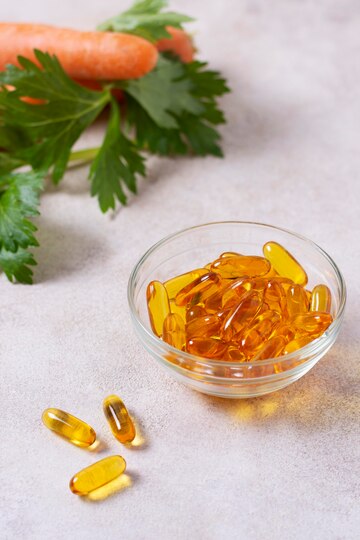Vitamin D is a fat-soluble vitamin that is crucial for maintaining overall health and well-being. Its primary function is to help the body absorb calcium, which is essential for building and maintaining strong bones.
One of the unique aspects of this vitamin is that the body can produce it when the skin is exposed to sunlight. This is why it’s often referred to as the “sunshine vitamin.” However, many people don’t get enough sun exposure to produce an adequate amount of this vitamin, especially during the winter months or in regions with limited sunlight.

Aside from sunlight, you can also obtain this vitamin from certain foods such as fatty fish (e.g., salmon, mackerel, tuna), fortified dairy products, eggs, and some fortified cereals.
Vitamin D deficiency can lead to various health problems, including weak bones (osteoporosis), increased risk of fractures, muscle weakness, and a weakened immune system.
To ensure you’re getting enough Vitamin D, it’s essential to maintain a balanced diet, spend time outdoors in the sunlight when possible, and consider supplements if necessary, especially if you have limited sun exposure or other risk factors for deficiency. Always consult with a healthcare professional before starting any new supplement regimen.
Sunshine Vitamin: Understanding and Harnessing Vitamin D
UVB Exposure
When your skin is exposed to sunlight, specifically UVB rays, it triggers a reaction in the skin cells. UVB radiation penetrates the skin and converts 7-dehydrocholesterol, a compound naturally present in the skin, into previtamin D3.
Conversion to Previtamin D3
Previtamin D3 is a photosensitive compound that forms in the skin as a result of UVB exposure. It is then converted into vitamin D3 (cholecalciferol) through a heat-dependent process within the skin.
Transport to Liver and Kidneys
Vitamin D3 is then transported to the liver and kidneys, where it undergoes further conversion to its active form, calcitriol. Calcitriol is the biologically active form of this vitamin that the body can use.

Regulation of Calcium Absorption
Calcitriol plays a crucial role in regulating calcium absorption in the intestines, which is essential for maintaining bone health and overall calcium balance in the body.
It’s important to note that the amount of this vitamin synthesized from sunlight depends on various factors, including the time of day, season, latitude, skin pigmentation, age, and the amount of exposed skin. Generally, exposing your skin to sunlight for about 10 to 30 minutes a few times per week, particularly during midday when UVB rays are strongest, can help your body produce an adequate amount of this vitamin.
However, it’s essential to balance sunlight exposure to avoid the risk of sunburn and skin damage. Sunscreen, clothing coverage, and avoiding prolonged exposure during peak sunlight hours can help mitigate these risks while still allowing for sufficient vitamin D synthesis. If you have concerns about your vitamin D levels or are unable to get enough sunlight exposure, consider speaking with a healthcare professional about supplementation or other dietary sources. Also learn more about ultimate workout.
7 Rich Sources of Vitamin D
Fatty Fish
Salmon, mackerel, trout, tuna, and sardines are excellent sources of vitamin D. Consuming these fish regularly can help increase your vitamin D intake.
Cod Liver Oil
Cod liver oil is derived from the liver of codfish and is a potent source of vitamin D, as well as vitamin A.
Fortified Foods
Many foods are fortified with this vitamin, including milk, orange juice, yogurt, and breakfast cereals. Check the nutrition labels to see if the product has been fortified with this vitamin.
Egg Yolks
Egg yolks contain small amounts of vitamin D. Opt for eggs from pasture-raised or free-range chickens, as they tend to have higher levels of vitamin D compared to conventionally raised eggs.
Beef Liver
Beef liver is another natural source of vitamin D, although it contains smaller amounts compared to fatty fish and cod liver oil.

Cheese
Some types of cheese, such as Swiss cheese, contain modest amounts of vitamin D.
Mushrooms
While most mushrooms contain minimal amounts of this vitamin, certain varieties like shiitake mushrooms can provide a decent source of this vitamin, especially when exposed to sunlight during growth.
Conclusion
Given its importance, ensuring adequate vitamin D intake through sunlight exposure, dietary sources, or supplementation is crucial for maintaining optimal health and preventing deficiencies and related health problems.


Its like you read my mind You appear to know so much about this like you wrote the book in it or something I think that you can do with a few pics to drive the message home a little bit but other than that this is fantastic blog A great read Ill certainly be back